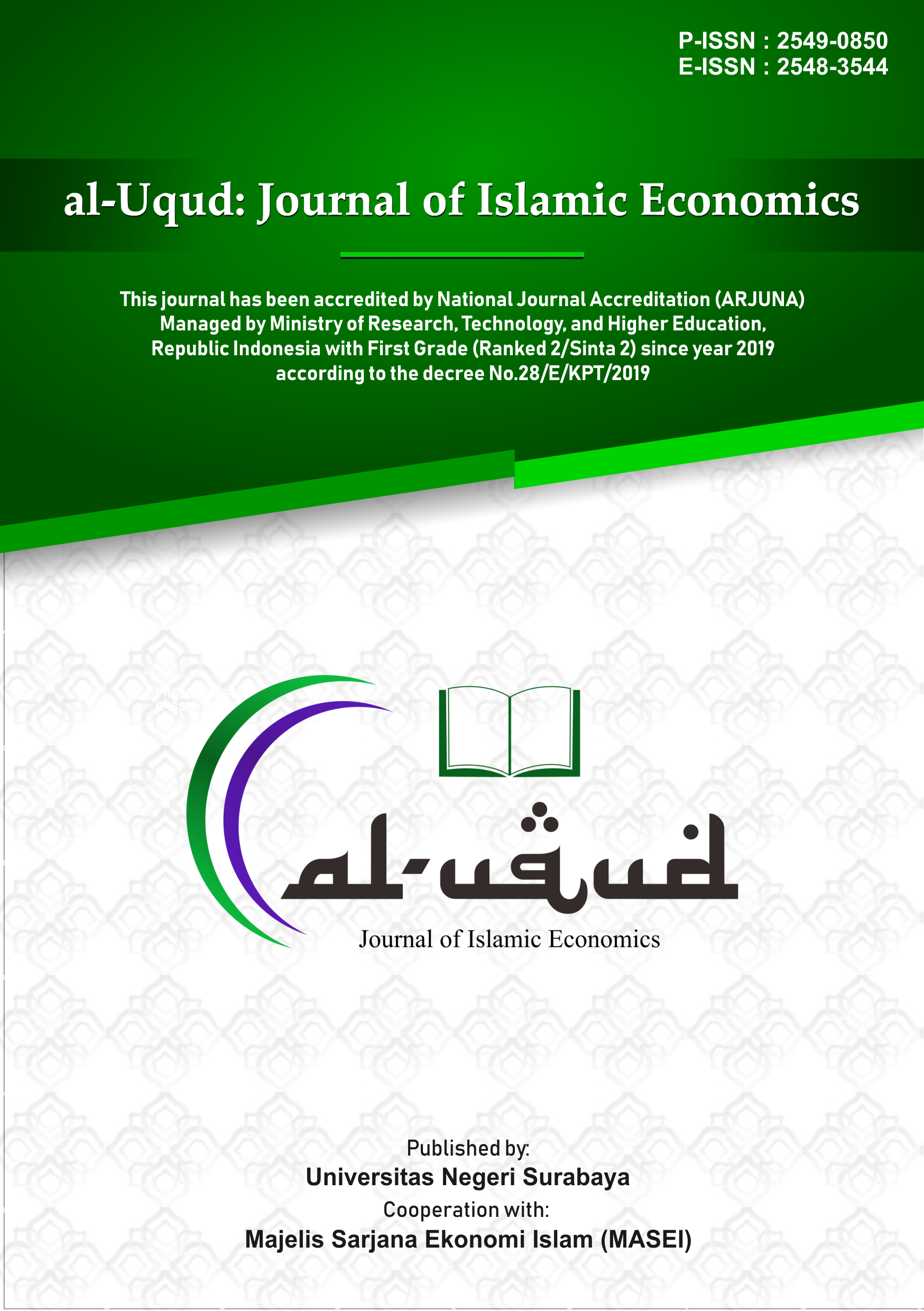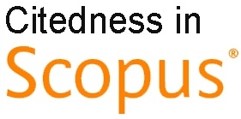Revisiting Zakat Distribution on Income Inequality and Welfare: The Malaysia Experience
DOI:
https://doi.org/10.26740/al-uqud.v4n1.p146-161Keywords:
Zakat Distribution, Income inequality, economics welfare, Gini coefficient and Lorenz curve, Atkinson Index, MalaysiaAbstract
This paper attempts to analyze the effects of zakat distribution on income inequality and welfare aspects of the poor Muslim society in Malaysia. The population of the study is the poor and hardcore poor of the zakat recipients in Selangor. Exploring the cross sectional micro level data of nine districts in Selangor, Malaysia, this study adopted Lorenz curve and Gini coefficient to represent positive measures of income inequality. However, these measures do not take into account the welfare effects of the distribution to the society. Hence, Atkinson index is adopted to represent the normative measures of inequality that takes into account the welfare effects of the zakat distribution to society. Results of the Gini coefficient and Lorenz curve have proven effectiveness of zakat distribution in reducing income inequality of the society. Whilst the theory of zakat says that zakat distribution will improve income inequality and welfare of the society, findings of the normative measures in this research show otherwise. Therefore, this study is extended with zakat distribution simulation model based on had kifayah. Results from the distribution simulation model proved the ability of zakat in narrowing down income inequality, reducing income loss and hence increasing the welfare of the society.
References
Ali, I., Azman, A., Singh, P., Singh, J., Drani, S., Hatta, Z. A & Akhter, T. (2019). Zakat as an Alternative of Microcredit for Poverty Reduction in Bangladesh. The Journal of Development Practice, 5(Annual), 1019. http://journals.dbuniversity.ac.in/ojs/index.php/jdp/article/view/739
Al Haq, M. A. & Norazlina, A. W. (2017) Effective Zakat Distribution: Highlighting Few Issues and Gaps in Kedah, Malaysia. Al-Iqtishad: Journal of Islamic Economics, 9 (2). pp. 259-288. ISSN 2087-135X
Atkinson, A. B. (1970). On the measurement of inequality. Journal of Economic Theory, 2(3), 244263. http://doi.org/10.1016/0022-0531(70)90039-6
Atkinson, A. B., & Brandolini, A. (2015). Unveiling the ethics behind inequality measurement: Daltons contribution to economics. Economic Journal, 125(583), 209234. http://doi.org/10.1111/ecoj.12225
Ayuniyyah, Q., Pramanik, A. H., Saad, N. M., & Ariffin, M. I. (2018). Zakat for Poverty Alleviation and Income Inequality Reduction. Journal of Islamic Monetary Economics and Finance, 4(1), 85100. http://doi.org/10.21098/jimf.v4i1.767
Bakar, M. A., & Ghani, A. A. (2011). Towards Achieving the Quality of Life in the Management of Zakat Distribution to the Rightful Recipients (The Poor and Needy). International Journal of Business and Social. https://doi.org/10.1787/459aa7f1-en
Beik, I. S., & Arsyianti, L. D. (2016). Measuring Zakat Impact on Poverty and Welfare Using Cibest Model. Journal of Islamic Monetary Economics and Finance. 1. 141-160. https://doi.org/10.21098/jimf.v1i2.524
Fikriyah, K., Ridlwan, A. A. (2018) The Evaluation of Mustahiq Empowerment-Based Poverty Alleviation Program at Amil-Zakat Organizations. International Journal of Islamic Business and Economics (IJIBEC), 2 (1), 65-73. https://doi.org/10.28918/ijibec.v2i1.1263
Fikriyah, K., Ridlwan, A. A., & Suryaningsih. (2019). International Journal of Civil Engineering and Technology 10 (02), 375381
Hassan, M. K. & Ahmed., M. (2000). œPoverty Alleviation and Zakat Funds : Substitutability of Zakat Funds in the Budget of the Government of Bangladesh, The Balance, Spring 2000.
Ibrahim, P. (2006). Economic Role of zakat in Reducing Poverty and income Inequality. Universiti Putra Malaysia. Retrieved from https://data.oecd.org/inequality/income-inequality.htm
Ibrahim, S. M. (2015). The Role of Zakat in Establishing Social Welfare and Economic Sustainability. International Journal of Management and Commerce Innovations, 3(1), 437441. https://www.academia.edu/14694602/The_Role_of_Zakat_in_Establishing_Social_Welfare_and_Economic_Sustainability
Jehle, G. A. (1994). Zakat and Inequality¯:Some Evidence From Pakistan. Review of Income and Wealth, 40(2). http://doi.org/10.1787/459aa7f1-en
Johari, F., Aziz, M. R. A., & Ali, A. F. M. (2014). The role of zakat in reducing poverty and income inequality among new convert (muallaf) in Selangor, Malaysia. Online Journal of Research in Islamic Studies, 1(3), 4356. https://doi.org/10.1787/459aa7f1-en
Kakwani, N. C. & Podder, N. (1976). Efficient Estimation of the Lorenz Curve and Associated Inequality Measures From Grouped Observations. Econometrica, 44(1), 137148. http://doi.org/10.1787/459aa7f1-en
Khasandy, E. A., & Badrudin, R. (2019). The Influence of Zakat on Economic Growth and Welfare Society in Indonesia. Integrated Journal of Business and Economics, 3(1), 65. http://doi.org/10.33019/ijbe.v3i1.89
Kopp, C. (2019). What is Income Inequality. http://doi.org/10.1787/459aa7f1-en
Kusuma, D. B. W., & Sukmana, R. (2010). œThe power of zakah in poverty alleviation Seventh International Conference The Tawhidi Epistemology: Zakat and Waqf Economy, Bangi 2010. http://www.ukm.my/hadhari/wp-content/uploads/2014/09/proceedings-seminar-waqf-tawhidi.pdf
Ventura, L. (2018). Wealth Distribution and Income Inequality by Country 2018. https://doi.org/10.1787/459aa7f1-en
Majlis Agama Islam Selangor Darul Ehsan. (1994). Fatwa Sistem Agihan Zakat Negeri Selangor Darul Ehsan. Selangor. Retrieved from https://data.oecd.org/inequality/income-inequality.htm
Mannan, M.A., Imtiazi I.A., Niaz M.A. & Deria A.H. (1989). Management of Zakat in Modern Muslim Society, Jeddah: Islamic Research and Training Institute, IDB.
Newberry, D. (2018). A theorem on the measurement of income inequality. Journal of Economic Theory, (2), 264266. http://doi.org/10.1787/459aa7f1-en
Nurjanah, F., Kusnendi, & Juliana. (2019). The Impact of Economic Growth and Distribution of Zakat Funds on Poverty (Survey in the Third District of West Java Province Period 2011-2016). In The 2nd International Conference on Islamic Economics, Business, and Philanthropy (ICIEBP) Theme: œSustainability and Socio Economic Growth (Vol. 3, p. 55). KnE Social Sciences. http://doi.org/10.18502/kss.v3i13.4195
Pyatt, G. (2018). On The Interpretation And Disaggregation of Gini Coefficients. The Economic Journal, 86(June). http://doi.org/10.1787/459aa7f1-en
Rohim, A. N. (2018). Maximizing Utility And Distributing Income Equitably: How does Zakah Impact Both of Them at Once? Islamic Economics Journal, 4(2), 155. http://doi.org/10.21111/iej.v4i2.2963
Ridlwan, A. A., (2017). The Determinant Factors of Motivation to Pay Zakat in Regional Amil Zakat Agency of East Java. KARSA: Journal of Social and Islamic Culture 25 (2), 334-345. http://doi.org/10.19105/karsa.v25i2.1398
Roslan, A. H. (2001). Income Inequality, Poverty And Development Policy In Malaysia. In Poverty and Sustainable Development. France. http://doi.org/10.1787/459aa7f1-en
Shorrocks, A. F. (2004). Inequality and Welfare Evaluation of Heterogenous Income Distributions. Journal of Economic Inequality, 2, 193218. http://doi.org/10.1787/459aa7f1-en
Wahab, M. B. A., Al-Junaidi, S. A. H., Omar, M. A. Bin, Ghazali, A. Bin, Osman, J. Bin, & Arif, M. (1995), œInstitutional Framework of Zakah: Dimensions and Implications Case Study of Malaysia, Seminar Proceedings No. 23, Jeddah: IRTI-IDB
Downloads
Published
How to Cite
Issue
Section
License
CC BY 4.0 Abstract views: 2715
,
Abstract views: 2715
, PDF Downloads: 1996
PDF Downloads: 1996








